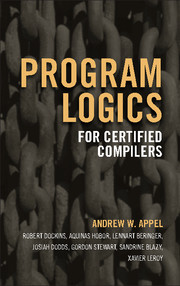Book contents
- Frontmatter
- Dedication
- Contents
- Road map
- Acknowledgments
- 1 Introduction
- I Generic separation logic
- II Higher order separation logic
- III Separation logic for CompCert
- IV Operational semantics of CompCert
- V Higher-order semantic models
- VI Semantic model and soundness of Verifiable C
- VII Applications
- Bibliography
- Index
III - Separation logic for CompCert
Published online by Cambridge University Press: 05 August 2014
- Frontmatter
- Dedication
- Contents
- Road map
- Acknowledgments
- 1 Introduction
- I Generic separation logic
- II Higher order separation logic
- III Separation logic for CompCert
- IV Operational semantics of CompCert
- V Higher-order semantic models
- VI Semantic model and soundness of Verifiable C
- VII Applications
- Bibliography
- Index
Summary
Synopsis: Verifiable C is a style of C programming suited to separation-logic verifications; it is similar to the C light intermediate language of the CompCert compiler. We show the assertion language of separation-logic predicates for specifying states of a C execution. The judgment form semax of the axiomatic semantics relates a C command to its precondition postconditions, and for each kind of command there is an inference rule for proving its semax judgments. We illustrate with the proof of a C program that manipulates linked lists, and we give examples of other programs and how they can be specified in the Verifiable C program logic. Shared-memory concurrent programs with Dijkstra-Hoare synchronization can be verified using the rules of concurrent separation logic.
- Type
- Chapter
- Information
- Program Logics for Certified Compilers , pp. 141Publisher: Cambridge University PressPrint publication year: 2014



